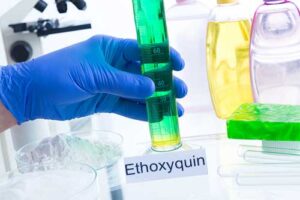When it comes to choosing the best food for our pets, we often focus on the big ingredients—the type of meat, the presence of grains, or the addition of vegetables. But lurking in many pet foods are smaller ingredients that can have a significant impact on your pet’s health: additives and preservatives.
Chemicals like BHA, BHT, and ethoxyquin are commonly used in pet food to prolong shelf life, but they come with potential risks that every pet owner should be aware of. In this post, we’ll dive into these specific chemicals, explore their potential dangers, and discuss why choosing food without these additives is a safer option for your furry friends.
What Are BHA and BHT?
BHA (Butylated Hydroxyanisole) and BHT (Butylated Hydroxytoluene) are synthetic antioxidants used in pet food to prevent fats from becoming rancid. While they help keep pet food fresh on the shelf, there’s growing concern about their safety.
Research says that BHA and BHT are classified as “reasonably anticipated to be human carcinogens” by the National Toxicology Program. Although these studies primarily focus on human health, the findings are concerning enough that they should make pet owners think twice about feeding foods containing these preservatives to their pets. A study published in the Journal of Clinical Oncology found that long-term exposure to BHA and BHT in lab animals increased the risk of cancer. While the direct link to pets has not been conclusively proven, the evidence is enough to raise red flags.
Moreover, these chemicals can cause other health issues in pets. Research says that prolonged exposure to BHA and BHT might contribute to liver and kidney damage, and some studies suggest a possible link to hyperactivity and other behavioral issues in dogs.
The Risks of Ethoxyquin
 Ethoxyquin is another preservative commonly found in pet foods, particularly in fish-based products. Originally developed as a pesticide, ethoxyquin is added to pet food to prevent fats from oxidizing and becoming rancid. However, its use in pet food has been a subject of controversy for years.
Ethoxyquin is another preservative commonly found in pet foods, particularly in fish-based products. Originally developed as a pesticide, ethoxyquin is added to pet food to prevent fats from oxidizing and becoming rancid. However, its use in pet food has been a subject of controversy for years.
A study published in the Journal of Veterinary Medicine found that ethoxyquin could be linked to liver and kidney damage in dogs. Research says that ethoxyquin might also contribute to other serious health problems, such as allergic reactions, skin issues, and even cancer. The U.S. Food and Drug Administration (FDA) has set a limit on the amount of ethoxyquin that can be added to pet food, but many experts argue that even low levels might pose a risk over time.
The concerns don’t stop there. Some reports have linked ethoxyquin to reproductive issues in pets, including reduced fertility and complications during pregnancy. Research says that pets consuming ethoxyquin over extended periods may face a higher risk of developing chronic health conditions, including organ damage and immune system dysfunction.
Why Are These Chemicals Still Used?
Given the potential risks, you might wonder why BHA, BHT, and ethoxyquin are still allowed in pet food. The primary reason is cost. These synthetic preservatives are inexpensive and effective at keeping pet food fresh for longer periods, making them appealing to manufacturers. They allow pet food to have a long shelf life, which is convenient for both producers and consumers.
However, the trade-off for this convenience could be your pet’s health. Research says that while these chemicals prevent spoilage, the long-term impact on your pet’s health could be far more costly in terms of veterinary bills and reduced quality of life.
The Benefits of Natural Preservatives
Fortunately, not all pet foods rely on synthetic chemicals to stay fresh. Many high-quality, natural pet foods use natural preservatives like vitamin E (often labeled as mixed tocopherols) and vitamin C (ascorbic acid). These natural alternatives might not extend shelf life as long as synthetic preservatives, but they are much safer for your pet.
A study in the Journal of Animal Science found that natural preservatives are just as effective in preventing spoilage without the associated health risks. Research says that pets fed diets free from synthetic additives like BHA, BHT, and ethoxyquin generally have better health outcomes, including improved energy levels, better coat condition, and a lower incidence of chronic diseases.
How to Avoid Harmful Additives
The best way to avoid harmful additives is to carefully read pet food labels. Look for foods that explicitly state they do not contain BHA, BHT, or ethoxyquin. Many premium pet food brands now proudly advertise that their products are free from these chemicals.
Here are some tips to help you choose safer pet foods:
- Look for Natural Preservatives: Choose pet foods that use natural preservatives like mixed tocopherols (vitamin E) and ascorbic acid (vitamin C).
- Check the Ingredient List: Avoid foods that list BHA, BHT, or ethoxyquin in the ingredients. Be aware that some foods may not explicitly list these preservatives, especially if they are added to individual ingredients like fish meal before they are included in the final product.
- Choose Fresh or Frozen Options: Fresh or frozen pet foods often contain fewer preservatives and can be a healthier option. These products are typically stored in the refrigerator or freezer, which eliminates the need for synthetic preservatives.
- Research the Brand: Look for pet food brands that prioritize natural ingredients and transparency. Brands that are committed to high-quality, natural ingredients often have stricter standards for what goes into their products.
Making the Switch to Safer Pet Foods
If you’ve been feeding your pet a diet that contains BHA, BHT, or ethoxyquin, it’s not too late to make a change. Transitioning to a safer, natural diet can help reduce the risk of potential health problems down the line.
Start by gradually mixing the new, additive-free food with your pet’s current food over a week or two. This slow transition will help your pet adjust to the new diet without digestive upset. Pay attention to how your pet responds—many owners report improvements in energy levels, coat condition, and overall well-being after making the switch.
Final Thoughts
The hidden dangers of common pet food additives and preservatives like BHA, BHT, and ethoxyquin are not something to be taken lightly. While these chemicals help keep pet food fresh on the shelf, the potential risks they pose to your pet’s health make them a less-than-ideal choice.
Research says that opting for natural preservatives and avoiding synthetic chemicals can lead to better health outcomes for your pet. By carefully reading labels and choosing high-quality, natural pet foods, you can help ensure your pet lives a long, healthy, and happy life.
As always, when it comes to your pet’s diet, knowledge is power. The more you understand about what’s in your pet’s food, the better equipped you’ll be to make choices that truly benefit their health.


